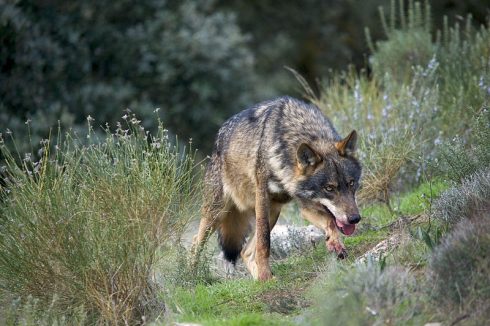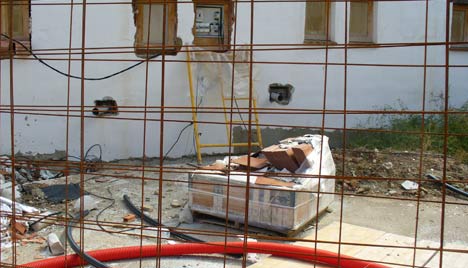Home to mainland Spain’s highest peaks, the Sierra Nevada is a treasure trove of rare plant life and animals
THE Sierra Nevada mountain range in Andalucía is a section of the Betic Cordillera and runs parallel to the Mediterranean Sea for around 100 kilometres. The temperature range is therefore dramatic with the summits under snow for many months, followed by a hot Mediterranean style summer. This creates special microclimates across the exposed rocky summits, glacial lakes and sheer sided gorges, mixed oak woods, pine woods and fast rivers with wooded banks.
Declared a National Park in 1998 and encompassing an area of 86,208 hectares, it is a popular destination throughout the year. It holds an exceptional variety of animal and plant life due to the combination of altitude and its proximity to the Mediterranean.
These mountains were formed during the Tertiary Period (65 to 1.8 million years ago), at the same point as the Atlas Mountains in Morocco and the European Alps. This mountain building event is called the Alpine Orogeny. The uplift happened as the African plate moved northwards colliding with the Eurasian plate.
The Sierra Nevada Mountains consist of mainly metamorphic rocks such as Gneiss and Mica schist. Many of the rocks are juxtaposed and mixed up due to intense faulting and folding during the compression of the two tectonic plates.

The parks lowest edge begins at 400 metres above sea level with the highest peaks situated to the western part of the sierras. They are Mulhacén (3,482m), Veleta (3,392m) and Alcazaba (3,366m); three peaks that are grouped together in a cluster.
This mountain range is comparable with the Alps with more than 20 peaks over 3,000m, but in a southerly and warmer part of Europe.
Mulhacén is the tallest summit in mainland Spain with the highest overall peak being Pico del Teide in the Canary Islands at 3,718m.
Flora
The Sierra Nevada and the Canary Islands have another similarity in that they carry the highest range of plant life in Spain.
The Sierra Nevada holds a quarter of the plants listed in Spain, around 116 of which are threatened and 66 endemic (solely from these mountains) having taken thousands of years to adapt in this difficult environment.
This is Europe’s most southerly glacial landscape where lichens are the most common vegetation, growing widely on the exposed and poor quality soils above 2,800m.
The last of these glaciers melted at the tail end of the 20th century, but there are around 50 glacial tarns (lakes held in the depressions created by the glaciers), the highest being the Laguna de Altera at 3,146 m.
In the Sierra Nevada summits (above 2,000 meters), there are damp pastures which are covered in snow for a great part of the year. They represent one of the most fragile and exclusive ecosystems of the massif known in Spanish as borreguiles. They contain a great vegetal biodiversity and this is where most of the Nevada endemics can be found.
The delicate balance for these plants is seriously threatened by the excessive grazing of livestock and these marshy grasslands and peat bogs will also alter with climate changes.
One of the more intriguing plants that grow on these humid grassland and watercourse edges above 2,000m is the carnivorous Pinguicula nevadensis.
The lilac blue flowers in June or July are on stems that reach 10 centimetres in height.
This endemic Butterwort has a sticky basal rosette of leaves onto which small insects get trapped. The leaves attract this extra food supply with their yellow colour and shiny substance. The victims get caught in the greasy coverage (mucilage) secreted by glands. Other glands are then stimulated to produce more digestive substances, suffocating and then breaking down the prey.
Some of the endemic plants of the sierra have reference to this in their names such as Verbascum nevadense, Saxifraga nevadensis, Arenaria nevadensis, Aquilegia vulgaris subsp. Nevadensis.
The names can also describe where they can be found; Linaria glacialis and Biscutella glacialis (high glacial areas) and Antirrhinum rupestre, which grows in rock fissures.
On lower slopes are groves of oak trees dominated by the evergreen Holm oak (Quercus ilex) with pyrenean oak (Q. pyrenaica) and sweet chestnut (Castanea sativa) woodlands. There are tracts of pine trees (Pinus sylvestris) combined with savin and common junipers (Juniperus sabina, J. communis).
Hawthorn (Crataegus monogyna), prickly juniper (Juniperus oxycedrus), lentisc (Pistacia lentiscus), wild olive trees (Olea europaea sylvestris), Mediterranean daphne (Daphne gnidium), Spanish barberry (Berberis hispanica) and butcher’s broom (Ruscus aculeatus) also cloth the slopes.
Lower valleys have a deciduous mix of gall oaks (Quercus faginea), Montpellier maple (Acer monspessulanum) and the native maple (Acer granatense). The oak, chestnut and pine forests give way to the rolling hills of land cultivated with almond trees, citrus groves and vineyards
The river banks are lined with poplar (Populus alba), alder (Alnus glutinosa), willow (Salix atrocinerea), ash (Fraxinus angustifolia) and elm (Ulmus minor).
Fauna
The easiest of the mammals to spot is the numerous Spanish ibex. Other mammals that inhabit the area but are nocturnal or secretive and therefore more difficult to see include wild boar, fox, badger, wild cat, weasel, beech marten and genet with the garden dormouse and wood mouse (Apodemus sylvaticus) at the smaller end of the scale.
This is the southern most habitat for the snow vole (Microtus nivalis). This vegetarian rodent lives on the scree slopes above the tree line. It is active both day and night and still finds grasses to eat underneath the winter snow.
The birdlife is varied with species inhabiting different areas to suit their requirements. The higher points attracting alpine accentor, red-billed chough, northern wheatear, black redstart, rock thrush and rock bunting. Ring ouzel can occasionally be seen.
Birds of prey that can be seen soaring or hunting from the sky are golden, booted and Bonelli’s eagles, peregrine falcon, kestrel, sparrowhawk, goshawk and the largest, which often seen in large groups, is the griffon vulture.
The areas of juniper are frequented by linnet, black-eared wheatear, thekla lark, crested lark, ortolan bunting with red-legged partridge hiding in the grassy areas.
Woodland areas contain birds such as short-toed treecreeper, Iberian green woodpecker, wood pigeon, turtle dove, coal tit, great tit, firecrest, goldfinch, jay and hoopoe.
Golden oriole and Wren plus a selection of warblers breed near the water courses.
The rivers contain trout and attract various amphibians and reptiles. The Betic midwife toad (Alytes dickhilleni) is on the Red List, marked as vulnerable. It is a species that is restricted to the mountains of south-eastern Spain.
Others include the Spanish painted frog (Discoglossus jeanneae), fire salamander (Salamandra salamandra), ocellated lizard (Timon lepidus nevadensis), spiny-footed lizard (Acanthodactylus erythrurus) and Bedriaga’s skink (Chalcides bedriagai).
The Sierra Nevada park has a list of 120 butterfly species recorded with some endemic to the area such as the Sierra Nevada blue (Polyommatus golgus), which flies above 2,400m altitude and the large and easily identified Apollo (Parnassius apollo nevadensis), which only flies in mountainous areas.
The resort of Pradollano is at 2,100m on the slopes of Veleta. This is a base for winter skiing along with Sol y Nieve, a higher ski station. The track from here to the village of Capileira in la Alpujarra is the highest pass through the mountain and is closed to vehicles. This pass is popular with hikers but great care must be taken in crossing these mountains as with any summits of this altitude the weather can change quickly and ill-equipped people can place themselves in great danger.
Clive and Sue launched wildsideholidays.com as an advertising medium for ethically-minded nature holiday businesses in Spain. The aim is to provide an internet site on which people searching for this type of holiday can easily find what they are looking for.
Together with iberianature.com, wildside holidays also run the iberianature forum (www.iberianatureforum.com) – the best online resource for learning about the nature of Iberia.
Where to Stay and Guided Activities
Spanish Highs
Walking, trekking, mountaineering, snow shoeing, ski touring, rock and snow adventures in the Sierra Nevada. Day or multi-day available with or without accommodation. Beginners, singles and groups welcome.
Hotel de Mecina Fondales
This Moorish style attractive and comfortable rural hotel lies in the heart of the Alpujarra Mountains in the province of Granada. The rooms are extremely spacious and there is a delightful swimming pool.
The Life of Riley
Offering walks, treks and scrambles in Andalusia’s Sierra Nevada and Alpujarra. Designed to suit your needs, our activities are led by a qualified mountain guide and UIAA environment partner.
El Bancalillo
A peaceful cortijo (cottage) for rent on the southern slopes of the Sierra Nevada National park. Ideally situated as a base for birdwatching, hiking, photography or just a relaxing tranquil break in the countryside.
Mountain House Holidays
Offering a range of walking and adventure activity holidays and breaks for people of all ages and abilities. Based in the foot hills of the Sierra Nevada mountains we have personally tried and tested our holidays and activities with our team of qualified and experienced leaders and instructors. We are always ready to tailor make the program to individual preferences or to design one specifically for your group.
Walking holidays in Alpujarra
Walking in Spain reaches new heights in The Alpujarra. We can help you discover this beautiful and spectacular region of Andalucia by arranging guided walks, walking holidays and painting holidays in the Alpujarra and Sierra Nevada. We have been providing our visitors with an insight to this beautiful area since 1994 and can offer the wealth of our personal experience and local knowledge.
Casa Alba
A holiday home in Orgiva, Las Alpujarras. Come alone, as a family, or as a group to Casa Alba to rejuvenate, relax, run a course, or have an activity-holiday.
Through our many local and international contacts we can run or help you run a variety of courses and activity-based holidays: tailor-made to your specification.
We also run “rejuvenation” holidays, which can be booked on an individual basis.
Itrabo Hills Bed & Breakfast
Come and experience life in a quiet, traditional Andalusian hill village with the beautiful surrounding mountains, valleys and rivers, whilst being close to the bustling beach resorts and the historic city of Granada









One Thing that has escaped being mentioned in this amazing article about the bio diversity of the Sierra Nevada mountains is the Minerology that it houses. It mentions the Glacial Metamorphic landscape but This landscape has also been volcanic in the past, where as producing the Sulphuric Hot Springs in Santa fe, and Alhama amoungst a few others.
Because of this change in the geographical nature of this region. The minerology of the area is quite abundant. One only has to look around whilst trekking along the Rio Guadalfeo in the Alpujarras to see an abundance of Garnets, Calcite, Pyrite, Black Tormaline, Chalcedony, fucite and of course Quarts. Mainly in mass form, But also crystaline structures Have been found in El Morreon, O Sel Ling and many more.
to the untrained eye the Garnet is probably the easiest to find, being scattered underfoot and in abundance. Housed genrally in a matrix of mica schist, being very silvery to the eye, and what looks to be peppered with tiny brown, red, or black dots. for the more of the red garnets, look more towards the green or blue Schist genrally found higher up the mountain barranco.
this to me, makes the Sierra Nevada, and especially the Alpujjara Mountains very special indeed. Forever peaking my interest as to what i may find next.
:-)
:-)
Ssshhh. They’ll dig it up next.
MORON not the city
Fucite you :)
I am going to Bubion on a self guided walking break on 3rd April for one week. Can anyone tell me what the weather conditions are likely to be and whet clothing I may need please?